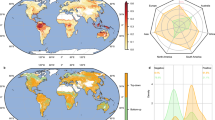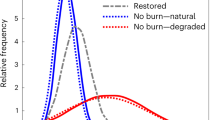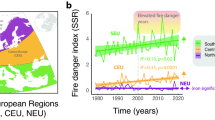Abstract
Carbon (C) emissions from wildfires are a key terrestrial–atmosphere interaction that influences global atmospheric composition and climate. Positive feedbacks between climate warming and boreal wildfires are predicted based on top-down controls of fire weather and climate, but C emissions from boreal fires may also depend on bottom-up controls of fuel availability related to edaphic controls and overstory tree composition. Here we synthesized data from 417 field sites spanning six ecoregions in the northwestern North American boreal forest and assessed the network of interactions among potential bottom-up and top-down drivers of C emissions. Our results indicate that C emissions are more strongly driven by fuel availability than by fire weather, highlighting the importance of fine-scale drainage conditions, overstory tree species composition and fuel accumulation rates for predicting total C emissions. By implication, climate change-induced modification of fuels needs to be considered for accurately predicting future C emissions from boreal wildfires.
This is a preview of subscription content, access via your institution
Access options
Access Nature and 54 other Nature Portfolio journals
Get Nature+, our best-value online-access subscription
$29.99 / 30 days
cancel any time
Subscribe to this journal
Receive 12 print issues and online access
$209.00 per year
only $17.42 per issue
Buy this article
- Purchase on Springer Link
- Instant access to full article PDF
Prices may be subject to local taxes which are calculated during checkout



Similar content being viewed by others
Data availability
The data used in this manuscript are archived at the Oak Ridge National Laboratory Distributed Active Archive Center (ORNL DAAC). https://doi.org/10.3334/ORNLDAAC/1744.
Code availability
No custom code or mathematical algorithms were used in the analyses of these data. The R code for our statistical analyses is available from the authors upon request, and each of the R packages used is referenced in the Methods.
References
Balshi, M. S. et al. Assessing the response of area burned to changing climate in western boreal North America using a multivariate adaptive regression splines (MARS) approach. Glob. Change Biol. 15, 578–600 (2009).
Flannigan, M. D., Krawchuk, M. A., de Groot, W. J., Wotton, B. M. & Gowman, L. M. Implications of changing climate for global wildland fire. Int. J. Wildland Fire 18, 483–507 (2009).
Calef, M. P., Varvak, A., McGuire, A. D., Chapin, F. S. & Reinhold, K. B. Recent changes in annual area burned in interior Alaska: the impact of fire management. Earth Interact. 19, 5 (2015).
Hanes, C. C. et al. Fire-regime changes in Canada over the last half century. Can. J. For. Res. 49, 256–269 (2018).
Flannigan, M. D., Logan, K. A., Amiro, B. D., Skinner, W. R. & Stocks, B. J. Future area burned in canada. Climatic Change 72, 1–16 (2005).
Amiro, B. D., Cantin, A., Flannigan, M. D. & de Groot, W. J. Future emissions from Canadian boreal forest fires. Can. J. Res. 39, 383–395 (2009).
Young, A. M., Higuera, P. E., Duffy, P. A. & Hu, F. S. Climatic thresholds shape northern high-latitude fire regimes and imply vulnerability to future climate change. Ecography 40, 606–617 (2017).
Van Wagner, C. E. Development and structure of the Canadian Forest Fire Weather Index System, vol. 35 (Canadian Forest Service, 1987).
de Groot, W. J., Pritchard, J. M. & Lynham, T. J. Forest floor fuel consumption and carbon emissions in Canadian boreal forest fires. Can. J. Res. 39, 367–382 (2009).
Flannigan, M. et al. Global wildland fire season severity in the 21st century. Ecol. Manag. 294, 54–61 (2013).
Field, R. D. et al. Development of a global fire weather database. Nat. Hazards Earth Syst. Sci. 15, 1407–1423 (2015).
Stocks, B. J. et al. Canadian forest fire danger rating system: an overview. For. Chron. 65, 258–265 (1989).
Walker, X. J. et al. Cross-scale controls on carbon emissions from boreal forest megafires. Glob. Change Biol. 24, 4251–4265 (2018).
Parisien, M.-A. et al. Contributions of ignitions, fuels, and weather to the spatial patterns of burn probability of a boreal landscape. Ecosystems 14, 1141–1155 (2011).
Thompson, D. K., Simpson, B. N. & Beaudoin, A. Using forest structure to predict the distribution of treed boreal peatlands in Canada. Ecol. Manag. 372, 19–27 (2016).
Turetsky, M. R. et al. Recent acceleration of biomass burning and carbon losses in Alaskan forests and peatlands. Nat. Geosci. 4, 27–31 (2011).
Whitman, E. et al. Variability and drivers of burn severity in the northwestern Canadian boreal forest. Ecosphere 9, e02128 (2018).
Boby, L. A., Schuur, E. A., Mack, M. C., Verbyla, D. & Johnstone, J. F. Quantifying fire severity, carbon, and nitrogen emissions in Alaska’s boreal forest. Ecol. Appl. 20, 1633–1647 (2010).
Ott, L. A. V. R. A., Mann, P. C. A. D. & Van Cleve, K. Successional Processes in the Alaskan Boreal Forest (Oxford Univ. Press, 2006).
Johnson, E. A. Fire and Vegetation Dynamics (Cambridge Univ. Press, 1992).
Hély, C., Bergeron, Y. & Flannigan, M. D. Effects of stand composition on fire hazard in mixed-wood Canadian boreal forest. J. Veg. Sci. 11, 813–824 (2000).
Rogers, B. M., Randerson, J. T. & Bonan, G. B. High-latitude cooling associated with landscape changes from North American boreal forest fires. Biogeosciences 10, 699–718 (2013).
Johnstone, J. F. et al. Fire, climate change, and forest resilience in interior alaska. Can. J. Res. 40, 1302–1312 (2010).
Walker, X. J. et al. Soil organic layer combustion in boreal black spruce and jack pine stands of the Northwest Territories, Canada. Int. J. Wildland Fire 27, 125–134 (2018).
Tarnocai, C. et al. Soil organic carbon pools in the northern circumpolar permafrost region. Glob. Biogeochem. Cycles 23, GB2023 (2009).
Flannigan, M. D. et al. Fuel moisture sensitivity to temperature and precipitation: climate change implications. Climatic Change 134, 59–71 (2016).
Veraverbeke, S., Rogers, B. M. & Randerson, J. T. Daily burned area and carbon emissions from boreal fires in Alaska. Biogeosciences 12, 3579–3601 (2015).
Bernier, P. Y. et al. Mapping local effects of forest properties on fire risk across Canada. Forests 7, 157 (2016).
Birch, D. S. et al. Vegetation, topography and daily weather influenced burn severity in central Idaho and western Montana forests. Ecosphere 6, art7 (2015).
Dillon, G. K. et al. Both topography and climate affected forest and woodland burn severity in two regions of the western US, 1984 to 2006. Ecosphere 2, art130 (2011).
Parks, S. A. et al. High-severity fire: evaluating its key drivers and mapping its probability across western US forests. Environ. Res. Lett. 13, 044037 (2018).
Johnstone, J. F., Hollingsworth, T. N., Chapin, F. S. & Mack, M. C. Changes in fire regime break the legacy lock on successional trajectories in Alaskan boreal forest. Glob. Change Biol. 16, 1281–1295 (2010).
Walker, X. J. et al. Increasing wildfires threaten historic carbon sink of boreal forest soils. Nature 572, 520–523 (2019).
Kelly, R. et al. Recent burning of boreal forests exceeds fire regime limits of the past 10,000 years. Proc. Natl Acad. Sci. USA 110, 13055–13060 (2013).
US EPA. Ecoregions of North America https://www.epa.gov/eco-research/ecoregions-north-america (2015).
Kasischke, E. S., Williams, D. & Barry, D. Analysis of the patterns of large fires in the boreal forest region of Alaska. Int. J. Wildland Fire 11, 131–144 (2002).
Stocks, B. J. et al. Large forest fires in Canada, 1959–1997. J. Geophys. Res. Atmos. 107, FFR 5-1–FFR 5-12 (2002).
Wang, T., Hamann, A., Spittlehouse, D. & Carroll, C. Locally downscaled and spatially customizable climate data for historical and future periods for North America. PLoS ONE 11, e0156720 (2016).
Johnstone, J. F., Hollingsworth, T. N. & Chapin, F. S., III. A key for predicting postfire successional trajectories in black spruce stands of interior Alaska, general technical report (USDA Forest Service, 2008).
R Development Core Team. R: a language and environment for statistical computing (2018).
Pinheiro, J. et al. Package ‘nlme’. Linear nonlinear mixed effects models version 3–1 (2017).
Zuur, A., Ieno, E. N., Walker, N., Saveliev, A. A. & Smith, G. M. Mixed effects models and extensions in ecology with R (Springer Science & Business Media, 2009).
Lenth, R., Singmann, H., Love, J., Buerkner, P. & Herve, M. Package emmeans: estimated marginal means, aka least-squares means (2019).
Oksanen, J. et al. Package vegan: community ecology package (2013).
Lefcheck, J., Byrnes, J. & Grace, J. Package piecewiseSEM: piecewise structural equation modeling (2018).
Shipley, B. Confirmatory path analysis in a generalized multilevel context. Ecology 90, 363–368 (2009).
Acknowledgements
This synthesis work for this project was supported by funding from the NASA Arctic Boreal and Vulnerability Experiment (ABoVE) Legacy Carbon grant NNX15AT71A awarded to M.C.M. The original field studies were supported by funding in the United States from NSF DEB RAPID grant no. 1542150 to M.C.M., NASA ABoVE grant NNX15AT83A to L.B.-C., NASA ABoVE grant NNX15AU56A to B.M.R., S.V. and M.T., Joint Fire Science Program grant 05-1-2-06 to J.F.J., NSF grant 0445458 to M.C.M., NSF support to the Bonanza Creek LTER (DEB-0423442); and in Canada from NSERC Discovery Grant funding to J.F.J. and M.R.T.; Government of the Northwest Territories Cumulative Impacts Monitoring Program Funding project #170 to J.L.B.; NSERC PDFs to N.J.D. and C.M.D.; GNWT logistical and financial support through the Laurier-GNWT Partnership Agreement; Polar Knowledge Canada’s Northern Science Training Program funding awarded to Canadian field assistants; S.V. acknowledges Vidi grant support from the Netherlands Organization for Scientific Research (NWO).
Author information
Authors and Affiliations
Contributions
M.C.M. and X.J.W. conceived the study with help from B.M.R. and S.V. Field data were contributed by L.B.-C., W.J.d.G., C.M.D., E.H., E.S.K., B.M.R., M.C.M., X.J.W. and E.W. Additional data were contributed by B.M.R., E.H., L.K.J., S.P., and S.V. X.J.W. combined the datasets and analysed the data with help from M.C.M., B.M.R. and S.V. X.J.W. led the writing in collaboration with M.C.M., J.F.J., B.M.R. and S.V. All authors read and edited this manuscript.
Corresponding author
Ethics declarations
Competing interests
The authors declare no competing interests.
Additional information
Peer review information Nature Climate Change thanks Gregory Dillon, Matthew Hurteau, Rachel Loehman and the other, anonymous, reviewer(s) for their contribution to the peer review of this work.
Publisher’s note Springer Nature remains neutral with regard to jurisdictional claims in published maps and institutional affiliations.
Supplementary information
Supplementary Information
Supplementary Figs. 1–6, Tables 1–9, discussion and references.
Rights and permissions
About this article
Cite this article
Walker, X.J., Rogers, B.M., Veraverbeke, S. et al. Fuel availability not fire weather controls boreal wildfire severity and carbon emissions. Nat. Clim. Chang. 10, 1130–1136 (2020). https://doi.org/10.1038/s41558-020-00920-8
Received:
Accepted:
Published:
Issue Date:
DOI: https://doi.org/10.1038/s41558-020-00920-8
This article is cited by
-
Simulating long-term wildfire impacts on boreal forest structure in Central Yakutia, Siberia, since the Last Glacial Maximum
Fire Ecology (2024)
-
Estimating wildfire potential in Taiwan under different climate change scenarios
Climatic Change (2024)
-
Wildfire precursors show complementary predictability in different timescales
Nature Communications (2023)
-
Fire History and Long-Term Carbon Accumulation in Hemi-boreal Peatlands
Ecosystems (2023)
-
Estimation of actual carbon dioxide removal in burned forests using satellite data: A case study in South Korea
Journal of Mountain Science (2023)



